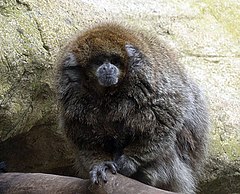Titi[16] (Callicebinae) – podrodzina ssaków naczelnych z rodziny sakowatych (Pitheciidae).
Szybkie fakty Domena, Królestwo ...
Titi
| Callicebinae |
| Pocock, 1925[1] |
|

Przedstawiciel podrodziny – titi białouchy (C. donacophilus) |
| Systematyka
|
| Domena
|
eukarionty |
| Królestwo
|
zwierzęta |
| Typ |
strunowce |
| Podtyp |
kręgowce |
| Gromada |
ssaki |
| Podgromada |
żyworodne |
| Infragromada |
łożyskowce |
| Rząd |
naczelne |
| Podrząd |
wyższe naczelne |
| Infrarząd |
małpokształtne |
| Parvordo |
małpy szerokonose |
| Rodzina |
sakowate |
| Podrodzina |
titi |
| Typ nomenklatoryczny |
|
Callicebus O. Thomas, 1903 |
| Synonimy |
|
- Callitricidae[uwaga 1] J.E. Gray, 1821[2]
- Callithricina: J.E. Gray, 1825[3]
- Callitrichina: J.E. Gray, 1849[4]
- Callitrichina: J.E. Gray, 1871[5]
- Callitriches: Winge, 1895[6]
- Xenothricidae[uwaga 2] Hershkovitz, 1970[7]
- Xenotrichidae: Hershkovitz, 1974[8]
- Xenothricinae: Szalay, 1976[9]
- Callicebina: Szalay & Delson, 1979[10]
- Callicebidae: Groves, 1989[11]
- Callicebini: H. Schneider, M.P.C. Schneider, Sampaio, Harada, Stanhope, Czelusniak & M. Goodman, 1993[12]
- Callicebini: McKenna & Bell, 1997[13]
- Xenotrichinae: McKenna & Bell, 1997[14]
- Xenotrichini: MacPhee & Horovitz, 2004[15]
|
|
| Rodzaje |
|
5 rodzajów (w tym 2 wymarłe) – zobacz opis w tekście |
|
|
|
|
|
Zamknij
Podrodzina obejmuje gatunki występujące w Ameryce Południowej[17][18].
Długość ciała 27–43,4 cm, długość ogona 37,2–54,6 cm; masa ciała 740–1650 g[18].
Tradycyjnie do podrodziny Callicebinae należał jeden rodzaj Callicebus[19] jednak Byrne i współpracownicy (2016) pozostawili w rodzaju Callicebus tylko gatunki C. personatus, C. coimbrai, C. barbarabrownae, C. melanochir i C. nigrifrons. Gatunki C. lugens, C. medemi, C. torquatus, C. lucifer, C. purinus i C. regulus zostały przez tych autorów przeniesione do odrębnego rodzaju Cheracebus, a pozostałe gatunki – do odrębnego rodzaju Plecturocebus[20]. Z badań Woods i współpracowników (2018) wynika, że przedstawicielem podrodziny jest również wymarły gatunek Xenothrix mcgregori z Jamajki[21] oraz Miocallicebus villaviejai z Kolumbii[22].
Do podrodziny należą następujące (występujące współcześnie i wymarłe po 1500 roku) rodzaje[23][17][16]:
- Xenothrix E.E. Williams & Koopman, 1952 – takson wymarły, jedynym przedstawicielem był Xenothrix mcgregori E.E. Williams & Koopman, 1952
- Cheracebus Byrne, Rylands, Carneiro, Lynch Alfaro, Bertuol, da Silva, Messias, Groves, Mittermeier, Farias, Hrbek, Schneider, Sampaio & Boubli, 2016
- Callicebus O. Thomas, 1903 – titi
- Plecturocebus Byrne, Rylands, Carneiro, Lynch Alfaro, Bertuol, da Silva, Messias, Groves, Mittermeier, Farias, Hrbek, Schneider, Sampaio & Boubli, 2016
Opisano również rodzaj wymarły w czasach prehistorycznych[22]:
- Miocallicebus Takai, Anaya, Suzuki, Shigehara & Setoguchi, 2001 – jedynym przedstawicielem był Miocallicebus villaviejai Takai, Anaya, Suzuki, Shigehara & Setoguchi, 2001
Typ nomenklatoryczny: Callithrix É. Geoffroy Saint-Hilaire, 1812 (= Callicebus O. Thomas, 1903).
Typ nomenklatoryczny: Xenothrix E.E. Williams & Koopman, 1952.
R.I. Pocock. Additional Notes on the External Characters of some Platyrrhine Monkeys. „Proceedings of the Zoological Society of London”. 95 (1), s. 45, 1925. DOI: 10.1111/j.1096-3642.1925.tb03341.x. (ang.). P. Hershkovitz. Notes on Tertiary platyrrhine monkeys and description of a new genus from the Late Miocene of Colombia. „Folia Primatologica”. 12 (1), s. 3, 1970. DOI: 10.1159/000155278. (ang.). P. Hershkovitz. A new genus of Late Oligocene monkey (Cebidae, Platyrrhini) with notes on postorbital closure and platyrrhine evolution. „Folia Primatologica”. 21 (1), s. 27, 1974. DOI: 10.1159/000155594. (ang.). F.S. Szalay & E. Delson: Evolutionary History of the Primates. New York: Academic Press, 1979, s. 293. ISBN 978-1-4832-8925-0. (ang.). C.P. Groves: A theory of human and primate evolution. New York: Oxford University Press, 1989, s. 1–375. ISBN 978-0-19-857758-4. (ang.). H. Schneider, M.P.C. Schneider, I. Sampaio, M.L. Harada, M.J. Stanhope, J. Czelusniak & M. Goodman. Molecular phylogeny of the New World monkeys (Platyrrhini, Primates). „Molecular Phylogenetics and Evolution”. 2 (3), s. 235, tabela 3, 1993. DOI: 10.1006/mpev.1993.1022. (ang.). Nazwy polskie za: W. Cichocki, A. Ważna, J. Cichocki, E. Rajska-Jurgiel, A. Jasiński & W. Bogdanowicz: Polskie nazewnictwo ssaków świata. Warszawa: Muzeum i Instytut Zoologii PAN, 2015, s. 40–41. ISBN 978-83-88147-15-9. (pol. • ang.). S.F. Ferrari, L.M. Veiga, L.P. Pinto, L.K. Marsh, R.A. Mittermeier & A.B. Rylands: Family Pitheciidae (Titis, Sakis and Uacaris). W: R.A. Mittermeier, A.B. Rylands & D.E. Wilson (redaktorzy): Handbook of the Mammals of the World. Cz. 3: Primates. Barcelona: Lynx Edicions, 2013, s. 459–464, 467–472. ISBN 978-84-96553-89-7. (ang.). D.E. Wilson & D.M. Reeder (redaktorzy): Subfamily Callicebinae. [w:] Mammal Species of the World. A Taxonomic and Geographic Reference (Wyd. 3) [on-line]. Johns Hopkins University Press, 2005. [dostęp 2020-11-05]. H. Byrne, A.B. Rylands, J.C. Carneiro, J.W.L. Alfaro, F. Bertuol, M.N.F. da Silva, M. Messias, C.P. Groves, R.A. Mittermeier, I. Farias, T. Hrbek, H. Schneider, I. Sampaio & J.P. Boubli. Phylogenetic relationships of the New World titi monkeys (Callicebus): first appraisal of taxonomy based on molecular evidence. „Frontiers in Zoology”. 13:10, 2016. DOI: 10.1186/s12983-016-0142-4. PMID: 26937245. PMCID: PMC4774130. (ang.). R. Woods, S.T. Turvey, S. Brace, R.D.E. MacPhee & I. Barnes. Ancient DNA of the extinct Jamaican monkey Xenothrix reveals extreme insular change within a morphologically conservative radiation. „Proceedings of the National Academy of Sciences of the United States of America”. 115 (50), s. 12769–12774, 2018. DOI: 10.1073/pnas.1808603115. PMID: 30420497. PMCID: PMC6294883. (ang.). M. Takai, F. Anaya, H. Suzuki, N. Shigehara & T. Setoguchi. A new platyrrhine from the Middle Miocene of La Venta, Colombia, and the phyletic position of Callicebinae. „Anthropological Science”. 109 (4), s. 292, 2001. DOI: 10.1537/ase.109.289. (ang.). N. Upham, C. Burgin, J. Widness, M. Becker, C. Parker, S. Liphardt, I. Rochon & D. Huckaby: Treeview of Mammalian Taxonomy Hierarchy. [w:] ASM Mammal Diversity Database (Version 1.11) [on-line]. American Society of Mammalogists. [dostęp 2023-09-13]. (ang.).
- M.C. McKenna & S.K. Bell: Classification of mammals above the species level. Nowy Jork: Columbia University Press, 1997, s. 1–631. ISBN 978-0-231-11013-6. (ang.).
Identyfikatory zewnętrzne:
